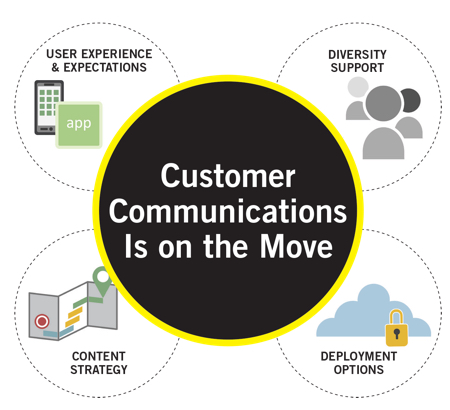This article appears in the Spring 2017 digital issue of DOCUMENT Strategy. Subscribe.

Image by: da-kuk , ©2017 Getty Images
There are many changes in the customer communications marketplace today. As a result, many are left with some big questions: What trends will affect organizations most significantly? What are the capabilities that will have an impact on customer communications, and how will they change the way you communicate with your customers? What are the prerequisites for putting these capabilities in place, and what should you be doing to improve the customer experience?
As a preview of this year’s DOCUMENT Strategy Forum, let’s look at the most significant changes, which we break down into four areas, including user experience and expectations, content strategy, diversity support, and deployment options.
1. Changes in Market Demand: User Experience & Expectations
- Increased mobility & ubiquitous access: We’ve been adapting to these demands for several years now, and we see more of the same. Content will need to become even more modular and responsive. Some may want to encode content so that it adapts to the communication channel/device as well.
- In-app notifications & real-time delivery: These notifications refer to the messages that pop up on our smartphones. Certainly, the battleground for most marketers today is enabling these notifications when consumers install an application. With changing demographics and the declining use of email communications by younger generations, the “in-app” notification capabilities become critical. Abuse them, and you risk being uninstalled. Neglect them, and you are missing a huge opportunity.
- Personalization: The increased need for personalization is driven by richer and richer content—thanks to profiling. We see many examples of this in marketing communications, but there is more opportunity for improvement with service-based communications as well. With geolocation, wearables, and the emergence of the Internet of things, the ability to tailor communications increases exponentially.
2. Changes in Market Demand: Content Strategy
- User-contributed content: Over the next several years, we see user-contributed content continuing to grow. It’s certainly a driving factor in consumer products and the travel industry, but it is also growing in areas like utilities (e.g., sharing ideas for energy savings) and financial services (e.g., tips on how to settle an estate upon the death of a parent).
- Artificial intelligence & chatbots: All the data collected in our interactions (primarily web and mobile apps) is being streamed into analytic tools, which use artificial intelligence to serve up new content. We use the term “chatbots:” robots that determine the next message or interaction.
- Syndication: Increasingly, organizations are consuming and distributing published content for their customers and trading partners. We see this growing, whether it be via social media or more formal channels (e.g., news outlets, public relations, etc.).
3. Changes in Market Demand: Diversity Support
- Multi-lingual support: Clearly, there is a growing need to support additional languages, but the ability to communicate clearly and concisely goes beyond basic translation services. Think Spanish first, but imagine Chinese soon.
- Americans with Disabilities Act (ADA) support: Supporting customers with disabilities demonstrates an organization’s interest in a broad spectrum of users. With the aging population, the increasing number of customers that are visually and hearing impaired will require ADA support.
4. Changes in Market Demand: Deployment Options
- Cloud and software as a service (SaaS): Organizations of all sizes and across most industries are pursuing cloud-first strategies. While we haven’t seen much offered to date in the customer communications management (CCM) space, it seems the tide is changing. Several suppliers are offering composition and publishing tools in the cloud. Think ExactTarget (now SalesForce) for paper, email, SMS, etc.
- Security & privacy: Personal information of all flavors is embedded in communications, requiring a level of supervision and security that increases every day. Organizations in all sectors need to monitor the collection, use, and disposition of personal information very deliberately.
- Agile methodologies: The last trend we see impacting communications is the use of agile methodologies—mostly in information technology (IT) organizations but also within the business functions. Rapid deployment has never been a characteristic of template development in most organizations, and now, turnaround expectations are even higher. Can the industry adapt?

©2017 DOCUMENT Strategy Media
Given these changes, what are the implications for organizations, and how can you prepare? Here is our guidance for those looking to adapt to this changing landscape.
5. Implications & Guidance: User Experience & Expectations
- Modular and adaptive content: Based on the need to deliver personalized content in a wide variety of channels and formats, we need to re-architect the way content is structured. Modular components assembled into “documents” has been an objective for many organizations for some time. Yet, these demands are increasing again. Adaptable content takes the notion of responsive design (a screen or webpage that changes layout based on the viewing device) and applies the principle to the content itself. For example, a fraud alert might be 50 words when viewed on a computer but just 10 when viewed on a phone. Adding this level of intelligence to communications can be complicated, but it will certainly be a requirement moving forward.
- Information architecture: Given that content will be used in many different contexts, having metadata and a very deliberate set of naming conventions is key. We describe the collection of techniques to “organize” content as information architecture. This must be prescriptive and not open to user interpretation. While this discipline is difficult to justify initially, given the extra time it takes, the dividends will be tremendous.
- Content & data: Content alone is no longer enough. We need to know statistics on how content is used, where, when, how often, and by whom. This data becomes critical to many of the rules and decision tools that serve different content to different users.
6. Implications & Guidance: Content Strategy
- Library services: At the foundation of a solid customer communications program is a repository that manages the modular content securely. This is critical, since most organizations have a multitude of repositories and delay consolidation and retooling. However, “kicking this can down the road” has hidden costs and will only further constrain the organization’s ability to manage content effectively.
- Curation: How does The New York Times continue to have compelling and relevant content for readers? Curation—a team of editors who decide on headlines, breaking news, etc. So, too, must an enterprise work with its customers. Again, we see this more often as it relates to marketing content, but we need the same competency on the service side.
- Collaboration: Inherent to several competencies we’ve highlighted (i.e., curation and user-contributed content) is the need for multi-party collaboration. In far too many organizations, email remains the workflow tool and the poor man’s version control, which consists of a cryptic numbering scheme that compliance, legal, or marketing may, or may not, have adopted. Most organizations have at their disposal some form of collaborative tools, such as SharePoint or something more high-powered. Why not use these tools to manage the customer communications publishing processes as well?
7. Implications & Guidance: Diversity Support
- New skills: The changes highlighted throughout this article certainly up the ante for skills within an enterprise. Understanding new languages, the tone in which we want to communicate with younger generations, and a willingness to go toe-to-toe with the folks in compliance and legal over concepts such as “brevity” and “clarity” call for some new blood in the communications department.
- Flexible contracting: In addition to recruiting some new talent, its highly likely that organizations will need a bevy of contractors with specific skills they can call upon periodically. Proactively setting these relationships is key. Far too often, we see organizations forced to make compromises and use preferred staffing firms that lack specialization. From our experience, many of the most talented communications professionals are independent. Buying 16 hours a month is the best value ever—if the mechanics are in place to do so, but knowledge transfer is the key. Make sure you have a solid plan to transfer skills and knowledge from the specialist to your internal staff.
8. Implications & Guidance: Deployment Options
- New suppliers: Given the move to the cloud and SaaS, we see organizations needing to investigate a new array of suppliers, as well as vetting some current ones that are bringing new offerings to the market. However, the process should be different than the last time you scanned the market (perhaps for a composition tool). Variable pricing models, agile development, and intellectual property are all very different today compared to 10 years ago, and we see a huge opportunity for improvement to unit costs and service-level agreements.
- Sourcing: Not to be overly critical, but sourcing organizations within enterprises are the antithesis of agile. Historically, we’ve set up five-year contracts (software, services, etc.) with little means to modify, short of a full-blown request for proposal (RFP). Now, we will need to contract for some limited services initially, expand later, and negotiate pricing as services are added. The good news is that many of the offerings are turnkey, one-size-fits-all, with published pricing.
- Governance: This is a word that gets thrown around a lot today, but in the context of customer communications, it means the set of “guardrails” we choose to use to manage communications: Who is responsible for which tasks (author, approve)? What metrics do we monitor to determine success or failure? Who has the “D” when compliance and the business disagree on language? What are our expectations for internal IT, and are they explicit? Creating and following governance disciplines doesn’t have a direct expense; thus, we don’t need to ask for funding, so why not give governance its due?
We look forward to discussing these trends and guidelines with you at the DOCUMENT Strategy Forum in May.
James Watson, Jr., PhD, is the President of Doculabs, a consultancy specializing in content-based applications. Don’t miss James’s session on the future of CCM on Tuesday, May 2 at the DOCUMENT Strategy Forum in Chicago.
James Watson, Jr., PhD, is the President of Doculabs, a consultancy specializing in content-based applications. Don’t miss James’s session on the future of CCM on Tuesday, May 2 at the DOCUMENT Strategy Forum in Chicago.
Tom Roberts is a Principal Consultant at Doculabs and has deep expertise in enterprise content management (ECM) and customer communications management (CCM) processes and technologies.













